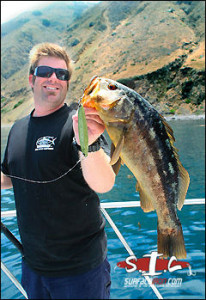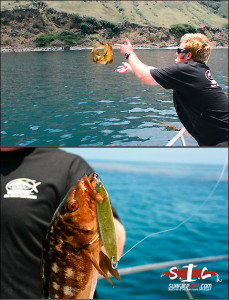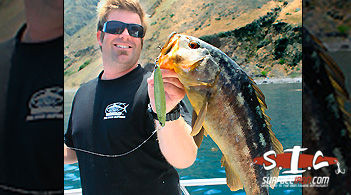Squid, swimbaits, slugs and creature baits may rule when it comes to fishing winter calico bass, but getting bit on the iron is still one of the funnest ways of catching calico bass — especially come winter when there is nothing else around to latch onto the surface irons.
Calico bass will eat the iron year ‘round. Catching bass on the jig — no what time of year it is — is all about putting in time with the long rod, and having the discipline to not put your hand in the bait tank or over the cutting board with squid on it.

“Sure they eat the jig this time of year,” says Danny Wade, one of San Diego’s most well respected jig fishermen. “It’s just that nobody is really doing it,” he says. “The half-day guys are fishing rockfish below the border. The guys that go to Clemente and fish bass this time of the year is about all you hear about. Unless you have a skiff, it’s not like you can go out and do it right now.”
Wade can remember plenty of mid-winter half-day trips where most anglers were fishing the squid and plastics, but the bass were more than willing to eat the jig. “I remember one day when JD (McGriff) was running the boat and we were fishing the I.B. Pipe. The guys were getting sculpin and sand bass on the squid and plastics, and every half hour or so a guy would get a calico,” remembers Wade. “I asked JD what the set-up was, and he told me where the pipe was, and how there were some stringers back behind the boat. I figured ‘what the hell’ and made a cast with a lure; I got bit on the sink before it hit the bottom… I ended up getting a limit of calico bass. It was the middle of winter.”
Any area that has kelp, or stones, or boilers — pretty much calico bass habitat in general — is ripe for the picking for getting bit on a surface iron. It’s just all about fishing it in the right spots and changing the retrieve/presentation for more lethargic winter fish.
“You have to let it sink,” says Wade. “You actually get a lot of bites on the sink. A lot of the fish is mid range on  down to the bottom. It’s not typically up high (in the water column) — unless you’re fishing in tight around the boilers and stuff.”
down to the bottom. It’s not typically up high (in the water column) — unless you’re fishing in tight around the boilers and stuff.”
Here’s Wade’s big three tips when it comes to catching winter bass on the surface iron: “Long cast, let it sink, slow retrieve.”
And fish 40-pound mono. Wade says that it helps the jig sink a little bit slower — which is a good thing when you’re hoping for bites on the sink in cold water.
When it comes to calico bass fishing, color arguably plays a bigger role than it does in any other part of successful iron fishing. Color might be overrated for some styles of surface iron fishing — like yellowtail and barracuda on San Diego ¾-day boats — but when it comes to bass, color matters. At least a little bit. At least at times.
“I’m no scientist, but it’s my understanding that bass have more cones and rods than something, like a yellowtail,” says Wade. “They see light and coloration better, at least that’s what I’ve heard.”
Wade likes to fish the Candy Bar 112 or Tady 45 in caterpillar yellow when fishing in and around the kelp stringers; for fishing the deeper water structure spots, a wounded soldier — military green with a red tail — has historically been a good jig.
Still, coloration doesn’t have to be obsessed over: “Something ‘greenie’ or ‘brownie’ is what you want… it’s the only time I really get into color,” says Wade of fishing jigs for calico bass.
Winter bass might not be as willing to jump on any of the “Big S” lures — swimbaits, slugs, surface irons — as they are come spring and summer, but if you pick your spots, there’s plenty of ways to get into winter bass. The surface iron is one of them.

